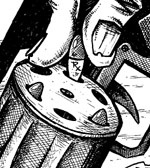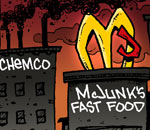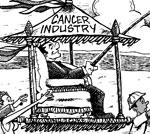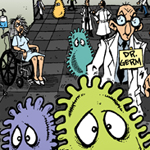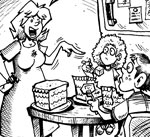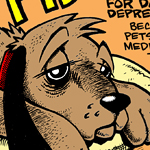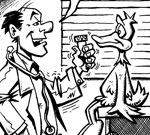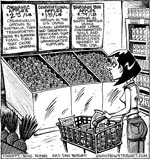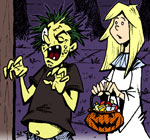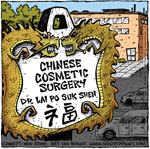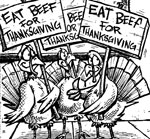Red Yeast Rice from a Holistic Perspective
| Share on Facebook | Share on Twitter | Share on Google+ |
If you keep up with natural health news, you have probably heard about (1) how red yeast rice lowers cholesterol and (2) how the US Food and Drug Administration knows red yeast rice lowers cholesterol and does not it to be standardized for medicinal use. I'll go over both of these points later in this article, but first I want to tell you the mostly untold story of how red yeast rice is used both as food and herbal medicine.
The Red Yeast Rice Fungus Among Us
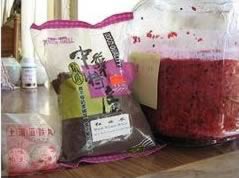
Red Yeast Rice in Chinese Grocery
Photo by Gluo88
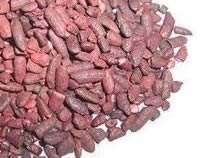
Dried Red Yeast Rice
Photo by Gluo88
The term red yeast rice is a little confusing. Red yeast rice is rice that has been infected with a fungus that leaves a red tint. It is the fungus that imparts both color to the dishes in which the rice is cooked and medicinal properties to Chinese herbal formulas.
It is also the fungus that creates a molecule identical to lovastatin used in the cholesterol drug Mevacor. But for centuries it was impossible to separate the fungus from the rice.
For at least 1,200 years, Chinese cooks have fermented ordinary non-glutinous (non-sticky, Chinese-style) white rice with a "starter" of molded red rice to make red yeast rice. The fungus is identified botanically as Monascus purpureus. It is also known as ang-khak rice mold and the color it imparts to rice is known as rice kernel discoloration. The mold also grows on corn stalks used as silage to feed cows. (Whether it lowers cholesterol in cows has not been researched.)
Growing red yeast rice at home is a project best left to experts, experts in Chinese cuisine, at least, if not in biology. What we call "red" yeast rice, the purpureus species of this fungus, is tasty and medicine. The botanically "red" species of this rice, Monascus rubrum, is toxic. But it is more likely to grow on salted fish than on stored rice.
Red Yeast Rice in Chinese Cuisine
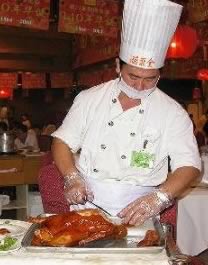
Chinese Chef Slicing Peking Duck
Photo by Yao Lei Lei
The main use of red yeast rice in Chinese cooking is adding flavor to bean curd, also known as tofu. A little red yeast rice is sprinkled on top of tofu to give the whole dish a tangy taste. Red yeast rice is also used to add the characteristic red color to Peking duck and barbecued pork. Some kinds of Japanese Koji sake are infused with red yeast rice.
To cook with red yeast rice, add the extract to the boiling water used to make a soup. Everything you put in the soup will turn red, but that's the intended effect. Or if you are really ambitious and you want to make your own Peking duck, use red yeast rice during the drying process to give a red color to the skin. Or boil red yeast rice to eat the same way you would eat regular rice.
You really can't lower your cholesterol by eating Peking duck every day. The amount of monacolin K (the cholesterol-lowering agent) in the red yeast rice used to dye a food is not significant. Sprinkling red yeast rice on tofu, on the other hand, probably provides enough monacolin K to make a difference, but the effect would be unpredictable.
While red yeast rice is used in Chinese and Japanese food, it only came to the attention of the West through Indonesian food. A Dr. van Tieghem who worked for the Dutch East India company noticed that the rice that now is part of a traditional rijkstaffel (Dutch version of an Indonesian buffet) was seasoned with yeast. He identified it as being in the same family as other color-producing molds and named it Monascus purpurea in 1895.
Red Yeast Rice in Traditional Chinese Medicine
The use of red yeast rice in Traditional Chinese Medicine was first recorded in the Ben Cao Gang Mu-Dan Shi Bu Yi, about 500 years ago. This encyclopedia is a sourcebook for both Chinese and Japanese herbal medicine. I became familiar with it when I was writing my book Japanese Herbal Medicine. The use of red yeast rice as a medicine was first described by the Chinese herbal master Li Shihzen.
Calling red yeast rice hongqu, Li Shihzen explained its properties in terms of "like attracts like" (in herbal medicine, if not in magnetism). Red yeast rice is, of course, red. Li attributed the red color with the ability of the food to attract circulation of the blood. And red yeast rice is also rice. As food, Li believed, red yeast rice attracted the digestion food.
The theory of Traditional Chinese Medicine actually was a lot more nuanced than just "like attracts like." Red yeast rice was deemed to be sweet, spicy, and warm. Therefore it was thought to act on the spleen, liver, and large intestine. It was thought to reduce "stagnation."
The idea of how red yeast rice could be used to cure a stomachache is analogous to the action of red yeast rice in lowering cholesterol. Hongqu was thought to stop "congestion" in the liver. The monacolin A in red yeast rice stops the production of "congesting" cholesterol by the liver. Hongqu was thought to help blood circulate upward in the body. Red yeast rice prevents cholesterol deposits in the arteries serving the brain.
Of course, Li Shihzen and his successors had no modern concept of cholesterol. Nonetheless, red yeast rice was recognized about 30 years ago as the source of an effective treatment for high cholesterol.
Red Yeast Rice and Cholesterol
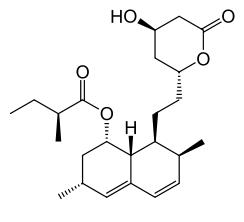
Lovastatin, Molecule Found in Red Yeast Rice
Scientists in Japan discovered the cholesterol-lowering effects of red yeast rice about the same time it was approved for use as a foodstuff. In the late 1970's, scientists in Japan verified that certain traditional foodstuffs were safe. In 1979, a Japanese researcher confirmed with laboratory experiments that red yeast rice contained a compound monacolin K that stopped the production of cholesterol in the liver. In 1982, the Chinese government approved red yeast rice as a food ingredient. The Chinese realized that they could make a proprietary drug from red yeast rice, and tested it in clinical trials in the 1990's.
The first clinical trial, which was conducted in China, tested the ability of red yeast rice to lower cholesterol in people who did not follow low-cholesterol diets. The researchers recruited 324 volunteers who had both high total cholesterol (230 mg/dl or higher) and high LDL cholesterol (120 mg/dl or higher). They were asked to take 1200 mg daily for 8 weeks. At the end of the study, the average effect on blood lipids was:
- 21% reduction in total cholesterol,
- 31% reduction in LDL cholesterol, and
- 34% reduction in triglycerides.
Researchers in China recruited a second group of 83 volunteers to follow a low-fat, low-cholesterol diet and also take 2400 mg of red yeast rice per day for 8 weeks. Half of the volunteers got red yeast rice, and half got a placebo. All adhered to the diet (this was a study conducted in China, after all). At the end of the trial, the volunteers who had taken the 2400 mg of red yeast rice in addition to dieting had:
- 17% better reduction in total cholesterol,
- 23% better reduction in LDL cholesterol, and
- 6% better reduction in triglycerides.
Or at least that's the way you will read the results in the journals. The "fine print" is that, in the second study, diet didn't lower cholesterol at all. And the higher dose of red yeast rice with diet actually got less effective results than a lower dose of red yeast rice without diet.
How could this be?
It turns out that red yeast rice does not always make the same amounts of monacolin K. If malt sugar is put into the rice used to make red yeast rice, the red yeast produces about four times more of the cholesterol-lowering ingredient.
From the standpoint of Traditional Chinese Medicine, this makes perfect sense. Malt sugar is used to calm the stomach. Adding malt sugar to the rice to make red yeast rice makes it more "stomach-settling." It would just be coincidental that the energetic effects of of adding malt sugar to red yeast rice would lower cholesterol even more.
Will Red Yeast Rice Help You Lower Cholesterol?
There many other articles on red yeast rice, including one written by me for this site, that explain how red yeast rice became controversial and severely limited by the US Food and Drug Administration. Rather than rehash the story you can read on hundreds of other sites, I'd rather tell you about how to be sure red yeast rice works for you for lowering cholesterol without any red yeast rice side effects such as muscle pain and memory loss.
There are three things you need to do:
1. Measure your progress objectively.
2. Don't diet unless your doctor insists on it.
First of all, please plan to measure your progress in lowering cholesterol objectively. Have a blood test that tells you what your numbers are before you start taking red yeast rice (or any other drug or supplement), and have that test done again about three months later. If a supplement is really working for high cholesterol, you can prove the effects with lower cholesterol numbers.
Then, unless your doctor tells you that it is absolutely essential, don't try to lower your cholesterol with both diet and red yeast rice. The way red yeast rice, at least in terms of Traditional Chinese Medicine, is to modify your digestion. Going on a diet and taking a traditional medicine that changes your diet at the same diet is overdoing it.
Also, if you are going to take red yeast rice, also take coenzyme Q10 and a complete B vitamin supplement. The reason for this is that one of the active ingredients in red yeast rice has the same chemical structure as the statin drug lovastatin, marketed in most of the English-speaking world as Mevacor. This chemical stops an enzyme that is essential not just to the production of cholesterol but also to the production of coenzyme Q10.
Red yeast rice with CoQ10 will take care of this problem. Vitamin B is taken separately.
Also, about 75 years ago the Japanese found that this yeast sometimes interferes with the action of the B vitamin thiamin. Published in Japanese in May of 1945, this study reported that people who ate very large quantities of red yeast rice because of food shortages developed beriberi, but the problem was not due to a vitamin deficiency. It was due to consuming enormous amounts of red yeast rice.
No one has ever developed beriberi after taking red yeast rice to lower cholesterol, but you never know what combination of effects might cause a very easily prevented B vitamin deficiency. I would take a complete B supplement just in case.
As I have mentioned elsewhere, the way the US FDA forces manufacturers of red yeast rice to manufacture and label their product, you don't really know how much of the cholesterol-lowering ingredients you are getting in one dose. Since there have never been any reports of the kinds of side effects associated with prescription statins in users of red yeast rice, I would say that doesn't make any difference. You won't overdose, and the effect of anything you would to control cholesterol takes at least a few weeks. You may get more cholesterol lowering one day than another when you take red yeast rice, but that is also the case with a statin drug.
That's also why red yeast rice dosage is not critical. You will get results by taking 1,000 to 3,000 mg a day. Less won't work, and more is not necessary.
As long as you are working with your health professionals, not against them, and you are relying on measurements, not guesswork, I think you may find a lot of benefit in red yeast rice. Just be sure to take your B supplement and coenzyme Q10, and evaluate every three months.
| Brand Name | Daily Dosage to Get Equivalent of 5 mg of Lovastatin | Cost Per Capsule (US $) |
| Choleast (Thorne Research) | 3 capsules | $0.25 |
| Cholestene Red Yeast Rice | 2 capsules | $0.20 |
| Doctors Best | 2 capsules | $0.07 |
| Nature's Sunshine Red Yeast Rice | 4 capsules | $0.07 |
| NSI Red Yeast Rice | 2 capsules | $0.07 |
| Solaray Red Yeast Rice | 7 capsules | $0.14 |
| Spring Valley Red Yeast Rice | 7 capsules | $0.23 |
Frequently Asked Reader Questions:
Q. Are there any red yeast rice dangers associated with citrinin?
A. Citrinin is a toxin released by a Penicillin mold. It is especially common on fruits grown in Bulgaria where average daily exposure to the toxin in the diet is 1 to 5 micrograms (millionths of a gram) per day. In Bulgaria, there is a higher rate of kidney disease like that caused by overdosing of antibiotics.
Several products have been tested and found to contain citrinin. For legal reasons, I won't tell you which two contain potentially toxic levels of citrinin, but they aren't linked from this site. Solaray and Nature's Sunshine do not contain toxic levels of citrinin.
Q. Should I take red yeast rice with policosanol?
A. It wouldn't hurt, but the supplement that gets even greater reductions in LDL cholesterol is fish oil. Taking fish oil with red yeast rice, in one study, resulted in LDL reductions of 42%.
Q. Will red yeast rice lower my blood pressure?
A. No. But you should monitor your blood pressure, too. If you find that taking red yeast rice has an effect on your blood pressure, please share them.
Selected References:
Albert, A. W. Chen, J. Kuron, G. Hunt, V. Huff, J. Hoffman, C. Rothrock, J. Lopez, M. Josua, H. Harris, E. Patchett, A. Monaghan, R. Currie, S. Stapley, E. Albers-Schonberg, G. Hensens, O. Hirshfield, J. Hoogsteen, K. Liesch, J. and Springer, J. Mevinolin: a highly potent competitive inhibitor of hydroxymethylglutaryl-coenzyme A reductase and a cholesterol-lowering agent. Proc. Natl. Acad. Sci. USA,77, 3957-3961 (1980).
Albert, A. W. Lovastatin and simvastatin-inhibitors of HMG CoA reductase and cholesterol-biosynthesis. Cardiology,77, 14-21 (1990).
Bok, J. W. and Keller, N. P. LaeA. A regulator of secondary metabolism inAspergillusspp. Eukaryotic Cell,3, 527-535 (2004).
Calvo, A. M. Wilson, R. A. Bok, J. W. and Keller, N. P. Relationship between secondary metabolism and fungal development. Microbiol. Mol. Biol. Rev. 66, 447-459 (2002).
Carvalho, J. C. Pandey, A. Babitha, S. and Soccol, C. R. Production of Monascus biopigments: an overview. Agro Food Ind. Hi-Tech,14, 37-42 (2003).
Casas-Lopez, J. L. Rodriguez-Porcel, E. M. Vilches-Ferron, M. A. Sanchez-Perez, J. A. Fernandez-Sevilla, J. M. and Chisti, Y. Lovastatin inhibits its own synthesis in Aspergillus terreus. J. Ind. Microbiol. Biotechnol. 31, 48-50 (2004b).
Casas-Lopez, J. L. Sanchez-Perez, J. A. Fernandez-Sevilla, J. M. Acien-Fernandez, F. G. Molina-Grima, E. and Chisti, Y. Fermentation optimization for the production of lovastatin by Aspergillus terreus: use of response surface methodology. J. Chem. Technol. Biotechnol. 79, 1119-1126 (2004a).
Casas-Lopez, J. L. Sanchez-Perez, J. A. Fernandez-Sevilla, J. M. Acien-Fernandez, F. G. Molina-Grima, E. and Chisti, Y. Production of lavastatin by Aspergillus terreus: effects of C:N ratio and the principal nutrients on growth and metabolite production. Enzyme Microb. Technol. 33, 270-277 (2003).
Chang, Y. N. Lin, Y. C. Lee, C. C. Liu, B. L. and Tzeng, Y. M. Effect of rice-glycerol complex medium on the production of lovastatin by Monascus ruber. Folia Microbiol. 47, 677-684 (2002).
Endo, A. Monacolin K, a new hypocholesterolemic agent produced by a Monascus species. J. Antibiotics(Tokyo),32, 852-854 (1979).
Endo, A. Kuroda, M. and Tsujita, Y. ML-236A, ML-236B, and ML-236C, new inhibitors of cholesterogenesis produced by Penicillium citrinium. J. Antibiotics(Tokyo),29, 1346-1348 (1976).
Hajjaj, H. Niederberger, P. and Duboc, P. Lovastatin biosynthesis by Aspergillus terreus in a chemically defined medium. Appl. Environ. Microbiol. 67, 2596-2602 (2001).
Hendrickson, L. Davis, C. R. Roach, C. Nguyen, D. K. Aldrich, T. McAda, P. C. and Reeves, C. D. Lovastatin biosynthesis in Aspergillus terreus: characterization of blocked mutants, enzyme activities and a multifunctional polyketide synthase gene. Chem. Biol. 6, 429-439 (1999).
Kennedy, J. Auclair, K. Kendrew, S. G. Park, C. Vederas, J. C. and Hutchinson, C. R. Modulation of polyketide synthase activity by accessory proteins during lovastatin biosynthesis. Science,284, 1368-1372 (1999).
Miyake, T. Mori, A. Kii, T. Okuno, T. Usui, Y. Sato, F. Sammoto, H. Watanabe, A. and Kariyama, M. Light effects on cell development and secondary metabolism in Monascus. J. Ind. Microbiol. Biotechnol. 32, 103-108 (2005).
Su, Y. C. Wang, J. J. Lin, T. T. and Pan, T. M. Production of the secondary metabolites -aminobutyric acid and Monacolin K by Monascus. J. Ind. Microbiol. Biotechnol. 30, 41-46 (2003).
Wang, J. J. Lee, C. L. and Pan, T. M. Improvement of Monacolin K, gamma-aminobutyric acid and citrinin production ratio as a function of environmental conditions of Monascus purpureus NTU 601. J. Ind. Microbiol. Biotechnol. 30, 669-676 (2003).
Wang, U. L. Houng, J. Y. Chang, H. S. Roger-Chien, H. and Hsu, W. H. Selection of drug-resistant mutant of Monascus pilosus for enhanced Monacolin K production. J. Chinese Agric. Chem. Soc. 36, 192-200 (1998).
-
Skin CareMen Skin Care
-
Free ResourcesFree eBooks
-
By creating an artificial environment, we're not stimulating our immune system enough. Germs are immune-stimulants. They challenge you to be prepared.Deepak Chopra
-
Featured Health Supplement
 The restoration and maintenance of normal organ and brain function and a strong immune system is the key to vibrant health and in
avoiding premature-aging!
The restoration and maintenance of normal organ and brain function and a strong immune system is the key to vibrant health and in
avoiding premature-aging!
-
